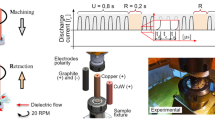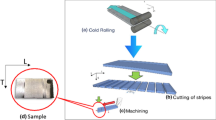Abstract
The feasibility of the electrochemical machining (ECM) of pure TiC, ZrC, TiB2 and ZrB2 has been established. In addition, the ECM behaviour of a cemented TiC/10% Ni composite has been investigated and compared to that of its components, TiC and nickel. ECM was carried out in 2M KNO3 and in 3 M NaCl at applied voltages of 10–31 V and current densities of 15–115 A cm−2. Post-ECM surface studies on the TiC/Ni composite showed preferential dissolution of the TiC phase during machining.
Similar content being viewed by others
Abbreviations
- E 0 :
-
thermodynamic equilibrium potential (V)
- F :
-
Faraday's constant (96 500 Coul mol−1)
- \(\dot x\) :
-
toolpiece feed rate (cm s−1 or mm min−1)
- I :
-
current (A)
- i :
-
current density (A cm−2)
- k :
-
electrolyte conductivity (Ω−1 cm−1)
- l :
-
interelectrode gap (mm)
- \(\dot m\) :
-
mass removal rate (g s−1 or g min−1)
- M :
-
formula weight (g mol−1)
- Q :
-
electrolyte flow rate (l min−1)
- t :
-
electrolyte temperature (°C)
- V :
-
applied voltage (V)
- V IR :
-
ohmic drop through electrolyte (V)
- z :
-
apparent valence of dissolution (eq mol−1)
- ηi :
-
overvoltages (V)
- ϱ:
-
density of refractory materials (g cm−3)
References
‘Engineering Properties of Selected Ceramic Materials’ (edited by J. F. Lynch, C. G. Ruderer and W. H. Duckworth), American Ceramic Society, Columbus, Ohio (1966).
‘Refractory Ceramics for Aerospace: A Materials Selection Handbook’ (edited by J. R. Hague et al.), American Ceramic Society, Columbus, Ohio (1964).
R. L. Sands and C. R. Shakespeare, ‘Powder Metallurgy: Practice and Applications’, William Clowes, London (1966).
P. Schwarzkopf and R. Kieffer, ‘Refractory Hard Metals: Borides, Carbides, Nitrides and Silicides’, MacMillan, New York (1953).
R. D. Cowling and H. E. Hintermann,J. Electrochem. Soc. 118 (1971) 1912.
M. Kh. Freid and S. A. Lilin,Sov. Electrochem. 15 (1979) 137.
S. Rambert, R. Sautebin and D. Landolt,Oberflaeche-Surface 22 (1981) 46.
Yu. A. Abramov and A. D. Davydov,Sov. Electrochem. 16 (1980) 342.
J. A. Petit, P. Lafargue, L. Porte and Tran Minh Duc,Electrochim. Acta 24 (1979) 1023.
J. Bannard,J. Appl. Electrochem. 6 (1976) 477.
4 (1974) 229.
J. B. Riggs, R. H. Muller and C. W. Tobias,Electrochim. Acta 26 (1981) 961.
B. A. Dissaux, MS Thesis, University of California, Berkeley, 1978. (LBL-8023).
C. A. Coughanowr, MS Thesis, University of California, Berkeley, 1982. (LBL-13682).
J. F. Wilson, ‘Practices and Theory of Electrochemical Machining’, Wiley, New York (1971).
Haselden Company, San Jose, California.
K. Kinoshita, D. Landolt, R. H. Muller and C. W. Tobias,J. Electrochem. Soc. 117 (1970) 1246.
D. Landolt, R. H. Muller and C. W. Tobias,118 (1971) 40.
J. F. Cooper, R. H. Muller and C. W. Tobias,127 (1980) 1733.
M. Datta and D. Landolt,Electrochem. Acta 25 (1980) 1263.
B. MacDougall,J. Electrochem. Soc. 127 (1980) 789.
M. Datta, H. J. Matthieu and D. Landolt,Electrochim. Acta 24 (1979) 843.
Author information
Authors and Affiliations
Rights and permissions
About this article
Cite this article
Coughanowr, C.A., Dissaux, B.A., Muller, R.H. et al. Electrochemical machining of refractory materials. J Appl Electrochem 16, 345–356 (1986). https://doi.org/10.1007/BF01008844
Received:
Revised:
Issue Date:
DOI: https://doi.org/10.1007/BF01008844




